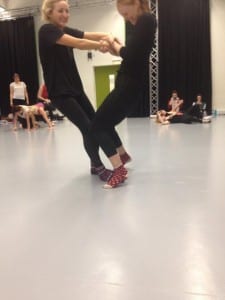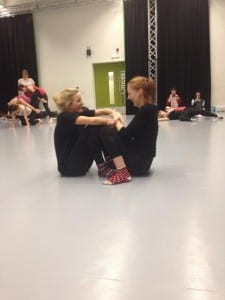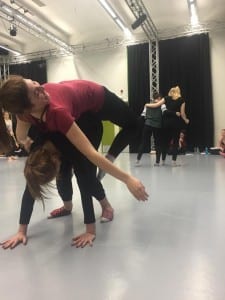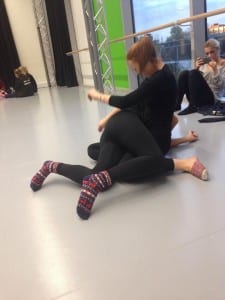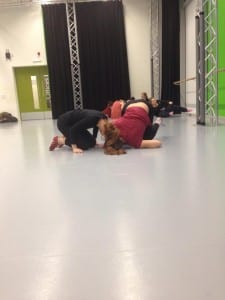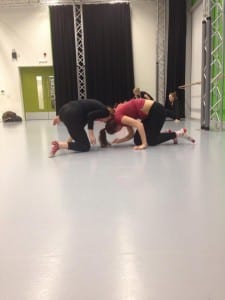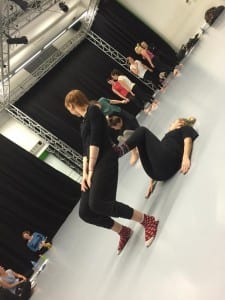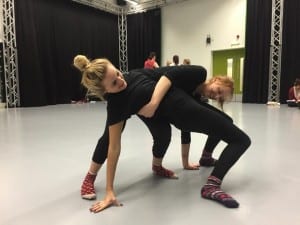This week, we decided to focus on the question ‘how can we transition between levels without just standing or falling through them?’ as we all agreed that during improvisational tasks or jam sessions, we tend to just stand from the floor if we feel like we have spent the majority of the time on a lower level instead of finding a way to transition between them. In order to explore and answer this, we focused on three different tasks that included:
- Keeping different body parts in contact while moving through different levels
- Responding to a time limit
- Figuring out the most complicated way to get from one level to the next.
Firstly we began by facing one another in partners keeping certain body parts in constant contact. Starting from the floor, we explored ways to lift ourselves by keeping our knees in contact in which rising to a higher level was easier as we were able to resist one another’s weight to pull ourselves up without losing contact. However from standing we found it difficult to lower to the floor without just falling or pulling one another to the ground. I also found I was still just standing to shift between levels, even though there was a sense of resistance between my partner and I, and when we tried to stand without this, only partner A was able to transition to a higher level by placing her weight onto her partner’s knees while she remained on a lower level. We decided that keeping our knees together restricted how we manoeuvred around the space making it difficult to transition through levels fluidly and coherently without someone dominantly pushing or pulling their partner to stand. In order to further explore this idea of facing one another, we decided to investigate how keeping our stomachs together would affect our movement. Originally before we did the task, we agreed that it would be easier to transition between levels as the partner’s connection allowed movement in their arms and legs to provide stability and mobility to move through the space as well as through different levels. However when we practically explored this, it was challenging to lift off the floor as we were both pushing against one another’s centres so much so that there was no where to move accept changing who was the over or under dancer. There was a moment where I was in table top position but my stomach was facing outwards instead of towards the ground, and my partner was resting on top of me in order to keep our stomach to stomach contact but as I couldn’t provide a stable base for her to give me her weight we immediately fell out of this position and onto the floor. We soon realised that to be able to transition between levels with ease, we had to provide our partner with a stable base to give and take weight in order to lift off from the floor and vice versa.
Therefore we began to explore shifting through levels either by facing the same way (stomach to back connection) or facing away from one another (back to back connection) to see how this would affect our movement quality or whether it was easier to transition through the space compared to facing one another. By facing the same way, partner A was able to provide a stable base using her back so that her partner could give her weight confidently and shift through levels much more fluently and easily. This was also enhanced as both partners were able to use their arms and legs to not only support their own weight but also their partner’s weight relying on one another’s movement to travel around the space as well as through various levels. Although I felt comfortable giving or taking my partner’s weight fully, keeping in contact this way, and was able to discover new ways to manoeuvre through this connection, I felt it was something I find myself habitually doing in jam sessions as it’s an easy way to provide a base for the person I’m improvising with. Whereas when we were facing away from one another, I felt more vulnerable and uneasy giving my partner my weight at first, as when I leaned over her back I was worried I’d carry on moving over her body and therefore found it difficult to relax my head and shoulders. However once we had explored numerous ways to shift between levels back-to-back, the movement became a lot more fluid as we began to trust one another’s strength enabling us to effortlessly change who was the under or over dancer as we were both able to provide a stable base for our partner.
Finally we explored ways to shift through levels keeping our heads in contact. All members of the group stated that they preferred this connection over the other body parts as the rest of the body was free to move and support one another, enabling the duo to find different ways to lift or fall through various levels as well as travel around the space with ease. Although maintaining head to head contact was easier, I still felt at times I was just standing to get to a higher level instead of listening or reacting to where my partner was moving to or from, whereas with the back-to-back or stomach-to-back connection I had to give or take weight in order to shift fluently through the space.
Developing on from this, we decided to explore how responding to given instructions, such as the body part to keep in contact and the direction to travel in, would affect the way we transitioned through levels and how this would ultimately affect our movement quality. As we were constantly changing the body part, it enabled us to explore new ways to change levels that previously we wouldn’t have thought to use and new ways to support each other’s weight. For example there was one moment where we were instructed to move to the floor keeping our stomachs in contact where I lifted my partner onto her side in order to maintain this connection, which was not only completely out of my comfort zone as I am normally the over dancer but also something I wouldn’t have even thought about trying in improvisational tasks or jam sessions. Although changing which body part to keep in contact felt awkward and clumpy, this exercise enabled me to understand and explore the vast variety of ways I could shift through the space, not only by directing the movement but also by being completely dependent and responding to the way in which my partner moved.
For our second task we incorporated a time limit in which we were given a certain amount of seconds to shift from one level to the next without a specific body part or direction. When we were given a shorter time, like two or three seconds, to change between levels, I found myself rushing to stand or fall so that we reached the desired level in time and reverted back to my habitual ways of moving. However the longer we had to transition between levels, the more creative we became with our movement as we had time to incorporate different levels into our duet before reaching the desired place. This also provided more opportunity to improvise and explore ways to travel around and through the space, developing a sense of open-mindedness when it came to movement and coherent weight exchange between my partner and I. The more we explored transitioning with a longer time limit, the more risks we began to take as a duet, incorporating lifts into how we got up and down in the space.
Keeping that in mind, our final task was focused around finding the most complicated way to transition between levels. Each time we were given a starting position and directed to either travel to a higher level or down to the floor, which allowed us to not only incorporate different body parts to shift between levels but also put emphasis on removing habitual movement patterns by starting in an unusual position. I’ve noticed that during jam sessions, I repeat certain movement that I feel comfortable and confident with, especially if working with a new partner however having a starting position pushed me outside of my comfort zone, allowing me to experiment with how much weight I could give or take in certain positions and where a sense of resistance or balance would take my movement next. The idea of finding the most complicated way focused on lingering in different levels before moving straight up or down in space, promoting a chance to play with gravity and constantly swap between who was the over or under dancer. It made me realise that incorporating levels into contact improvisation doesn’t just mean immediately changing from being on the floor to standing or vice versa but the focus is on the idea of lingering and playing with space and levels and how that affects the movement direction and the relationship between the people dancing.
Although we explored transitioning between levels through various tasks and touched briefly on the questions below, we would investigate and integrate them fully if we were to develop our research lab further:
- How can we transition through levels instead of using the simplest route?
- How can lifts be incorporated when travelling through levels?
- How does facing different directions change the role of the under and over dancer?
- How does a time limit change the complexity of the movement?
Jam
This weeks jam session focused on blindfolded contact improvisation, which was something I was extremely excited to try. By removing my sight, I heavily relied on hearing for people close to me and sensing if someone was improvising around me. At first moving while blindfolded felt very disorientating as I couldn’t figure out where I was in the space or who was around me. However after a while I began to feel comfortable in my surroundings and confident to take bigger risks when it came to giving or taking other’s weight, even though I couldn’t see who I was improvising with. The fact I didn’t know who I had danced with suggested that no matter who my partner is, there can always be a constant weight exchange, shifting between who is the under or over dancer – which is something I will keep in mind in normal improvisational or jam sessions.
Citation
Keefe, M. (2003) What’s the score? Improvisation in Everyday Life. In: Ann Cooper Albright and David Gere (eds) Taken by surprise: A dance improvisation reader. Middletown, Conneticut: Wesleyan University Press, 229-238.
